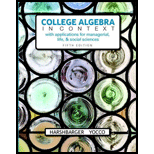
Determine if each ordered pair is a solution of the system of equations given.
1.
- a. (2, 1)
- b. (−2, 1)
Want to see the full answer?
Check out a sample textbook solution
Chapter 2 Solutions
College Algebra in Context with Applications for the Managerial, Life, and Social Sciences (5th Edition)
- The expression (w.wx+8) represents the number of miles Trent jogged during a race, and 5x represents the number of miles that Ling jogged during the same race, in x hours. Write and simplified expression to show how many more miles Ling jogged than Trentarrow_forwardFirm Alpha operates in a perfectly competitive market in a constant-cost industry and is earning negative economic profit. a. How does Firm Alpha determine its profit-maximizing quantity of output? Explain. b. Draw correctly labeled side-by-side graphs for Firm Alpha and the market it operates in. Label the axes and all of the following: i. Market price (PE) and market quantity (QE) ii. The firm's quantity of output (Qe) iii. The firm's average total cost (ATC) c. Completely shade the area of the firm's total cost. d. Identify whether the following increase, decrease, or remain constant as the market moves to long-run equilibrium: i. Market equilibrium quantity ii. Market equilibrium price e. Assume the product that Firm Alpha produces has a negative externality. Draw the marginal social cost (MSC) on the market graph from part (b). f. Will the unregulated market produce more or less than the socially optimal quantity? g. Label the socially optimal quantity (Qso) for the market on your…arrow_forwardGoods A, B, and C are related goods, each operating in a perfectly competitive market. a. As the price of Good A increases from $8 to $10, its quantity demanded falls from 200 units to 160 units. Calculate the price elasticity of demand for this range. b. Good A is an input for Good B. Illustrate the effect of the price change from part (a) on a fully labeled supply and demand graph for Good B. Label the equilibrium price(s) and quantity or quantities. Use arrows to indicate any shifts. c. On your graph from (b), shade the consumer surplus lost in the market for Good B as a result of the change in part (a). d. The equilibrium price for Good C is $2, and the equilibrium quantity is 60 units. The cross-price elasticity of Good C with Good A is -3. i. Are Good C and Good A normal goods, inferior goods, complementary goods, or substitute goods? ii. Calculate the new equilibrium quantity of Good C after a 25% price increase for Good A.arrow_forward
- Let a = (-4, 5, 4) and 6 = (1,0, -1). Find the angle between the vector 1) The exact angle is cos 2) The approximation in radians isarrow_forwardThe only problems I need help with ae the last 8 ones, Thanksarrow_forwardPrice (S) The graph below depicts a firm with market power. In the graph, MC represents the firm's marginal costs, ATC represents the average total costs, D represents demand, and MR represents marginal revenue. 110 70 60 50 40 30 20 MC ATC D 0 40 50 70 80 95 Quantity/Units MR a. At 60 units of output, how much would this profit-maximizing monopolist charge? b. How many units would it produce to maximize total revenue rather than total profit? c. What is the maximum quantity this firm can produce without incurring economic losses? d. Calculate the firm's profit at the profit-maximizing output and price. e. Why is this firm's marginal revenue curve below its demand curve? Explain.arrow_forward
- A well-known company predominantly makes flat pack furniture for students. Variability with the automated machinery means the wood components are cut with a standard deviation in length of 0.45 mm. After they are cut the components are measured. If their length is more than 1.2 mm from the required length, the components are rejected. a) Calculate the percentage of components that get rejected. b) In a manufacturing run of 1000 units, how many are expected to be rejected? c) The company wishes to install more accurate equipment in order to reduce the rejection rate by one-half, using the same ±1.2mm rejection criterion. Calculate the maximum acceptable standard deviation of the new process.arrow_forwardFind the (exact) direction cosines and (rounded to 1 decimal place) direction angles of = (3,7,6)arrow_forwardShade the areas givenarrow_forward
- 5. Let X and Y be independent random variables and let the superscripts denote symmetrization (recall Sect. 3.6). Show that (X + Y) X+ys.arrow_forwardLet a = (-1, -2, -3) and 6 = (-4, 0, 1). Find the component of b onto a.arrow_forwardForces of 9 pounds and 15 pounds act on each other with an angle of 72°. The magnitude of the resultant force The resultant force has an angle of pounds. * with the 9 pound force. The resultant force has an angle of with the 15 pound force. It is best to calculate each angle separately and check by seeing if they add to 72°.arrow_forward
 Algebra: Structure And Method, Book 1AlgebraISBN:9780395977224Author:Richard G. Brown, Mary P. Dolciani, Robert H. Sorgenfrey, William L. ColePublisher:McDougal Littell
Algebra: Structure And Method, Book 1AlgebraISBN:9780395977224Author:Richard G. Brown, Mary P. Dolciani, Robert H. Sorgenfrey, William L. ColePublisher:McDougal Littell Glencoe Algebra 1, Student Edition, 9780079039897...AlgebraISBN:9780079039897Author:CarterPublisher:McGraw Hill
Glencoe Algebra 1, Student Edition, 9780079039897...AlgebraISBN:9780079039897Author:CarterPublisher:McGraw Hill
 Holt Mcdougal Larson Pre-algebra: Student Edition...AlgebraISBN:9780547587776Author:HOLT MCDOUGALPublisher:HOLT MCDOUGAL
Holt Mcdougal Larson Pre-algebra: Student Edition...AlgebraISBN:9780547587776Author:HOLT MCDOUGALPublisher:HOLT MCDOUGAL Elementary AlgebraAlgebraISBN:9780998625713Author:Lynn Marecek, MaryAnne Anthony-SmithPublisher:OpenStax - Rice University
Elementary AlgebraAlgebraISBN:9780998625713Author:Lynn Marecek, MaryAnne Anthony-SmithPublisher:OpenStax - Rice University College Algebra (MindTap Course List)AlgebraISBN:9781305652231Author:R. David Gustafson, Jeff HughesPublisher:Cengage Learning
College Algebra (MindTap Course List)AlgebraISBN:9781305652231Author:R. David Gustafson, Jeff HughesPublisher:Cengage Learning





